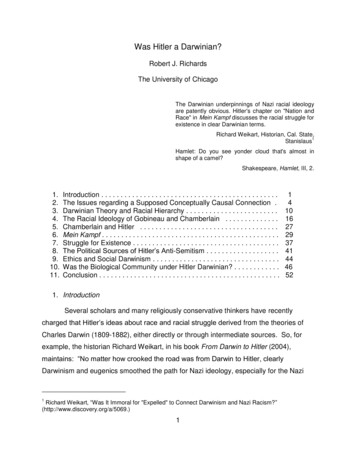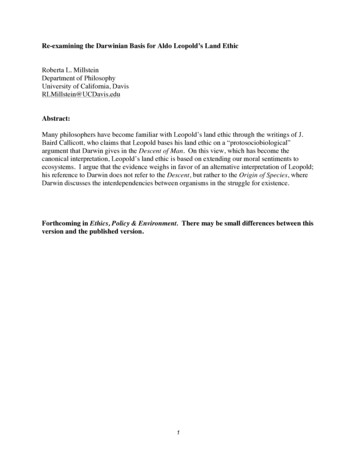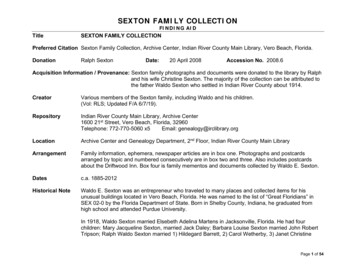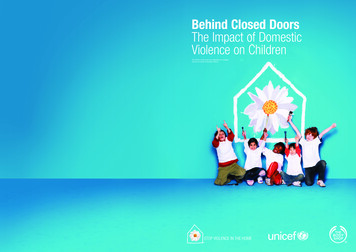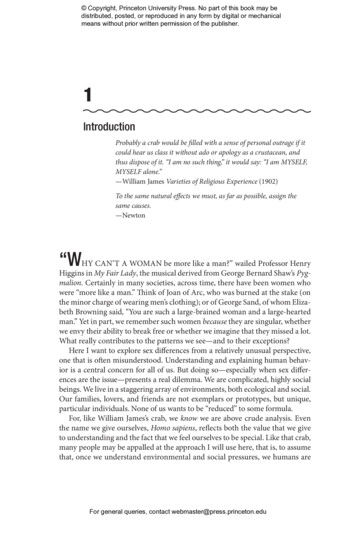
Transcription
Copyright, Princeton University Press. No part of this book may bedistributed, posted, or reproduced in any form by digital or mechanicalmeans without prior written permission of the publisher.1IntroductionProbably a crab would be filled with a sense of personal outrage if itcould hear us class it without ado or apology as a crustacean, andthus dispose of it. “I am no such thing,” it would say: “I am MYSELF,MYSELF alone.”— William James Varieties of Religious Experience (1902)To the same natural effects we must, as far as possible, assign thesame causes.— Newton“WHY CAN’T A WOMAN be more like a man?” wailed Professor HenryHiggins in My Fair Lady, the musical derived from George Bernard Shaw’s Pygmalion. Certainly in many societies, across time, there have been women whowere “more like a man.” Think of Joan of Arc, who was burned at the stake (onthe minor charge of wearing men’s clothing); or of George Sand, of whom Elizabeth Browning said, “You are such a large- brained woman and a large- heartedman.” Yet in part, we remember such women because they are singular, whetherwe envy their ability to break free or whether we imagine that they missed a lot.What really contributes to the patterns we see— and to their exceptions?Here I want to explore sex differences from a relatively unusual perspective,one that is often misunderstood. Understanding and explaining human behavior is a central concern for all of us. But doing so— especially when sex differences are the issue— presents a real dilemma. We are complicated, highly socialbeings. We live in a staggering array of environments, both ecological and social.Our families, lovers, and friends are not exemplars or prototypes, but unique,particular individuals. None of us wants to be “reduced” to some formula.For, like William James’s crab, we know we are above crude analysis. Eventhe name we give ourselves, Homo sapiens, reflects both the value that we giveto understanding and the fact that we feel ourselves to be special. Like that crab,many people may be appalled at the approach I will use here, that is, to assumethat, once we understand environmental and social pressures, we humans areFor general queries, contact webmaster@press.princeton.edu
Copyright, Princeton University Press. No part of this book may bedistributed, posted, or reproduced in any form by digital or mechanicalmeans without prior written permission of the publisher.2 C hapter 1as predictable as other animals in our behavior and are governed by the samerules. And I want to begin with simple rules, no less.Many of us assume that humans operate under rules that are different fromthese other species, that our rules are based entirely on culture rather than onbiology, or some combination. I will ask: what can we learn if we begin withoutassuming that this were true? I want to begin by exploring what a biologistwould predict if he or she knew only that here was a smart, upright- walking,highly social primate and nothing more. I will explore the ecology of being maleand female, beginning with simple rules and with what I can discern about theenvironments with which the evolutionary rules interact.The approach I use, behavioral ecology, is an evolutionary approach with rootsin Charles Darwin’s work. It focuses on the question, how do environmentalconditions influence our behavior and our lifetimes? This approach has provedprofitable in exploring other realms of human behaviors.1 Behavioral ecologyand its intellectual relatives seek to understand how comparatively simple operating rules interact with historical accidents, and with temporal and spatialspecifics, to yield a rich diversity of patterns. There is no doubt that genes influence not only our physical structure and physiology but also our behavior;there is no doubt that historical accident often plays a role, nor is there anydoubt that cultural and social pressures can influence behavior. But where liesthe balance? Perhaps by beginning with very simple rules and assumptions, andfinding where they fail to predict well, we can gain some insight.2Vampire Stories and BeyondHumans have always sought to explain the patterns they see. In fact, one of thestrongest selective forces on human behavior has been to understand pattern— not only in order to deal with environmental variation but also to be the first inone’s tribe who is able to predict events and when they will occur (imaginebeing the first human to predict a solar eclipse). But creating stories that moreor less match our observations is not science but folklore.Consider vampires. From Bram Stoker through Anne Rice, from Bela Lugosi to Tom Cruise and Leslie Nielson, vampires have always fascinated us: aristocratic, sexy, dangerous, and (almost) invincible. Vampire folklore provides awonderful example of how our need to explain can drive us to spin stories thatseem to explain something that we see, and that can be hard to refute, but thatnonetheless do not reflect what actually happens.The folklorist Paul Barber, in a delightful examination of vampire mythsaround the world, notes that the ways people in preindustrial societies interpreted phenomena associated with death and the decay of corpses are “fromour perspective, quite wrong. What makes them interesting, however, is thatFor general queries, contact webmaster@press.princeton.edu
Copyright, Princeton University Press. No part of this book may bedistributed, posted, or reproduced in any form by digital or mechanicalmeans without prior written permission of the publisher.I ntroduction 3they are also usually coherent, cover all the data, and provide the rationale forsome common practices that seem, at first, to be inexplicable.”3The variety of myths and legends about vampires all begin simply: death— especially unexpected or unusual death— brings more death. If someone died,“why” was usually unknown, and epidemics leading to death and more deathwere once far more common than today. Once people were buried (often without coffins), not all corpses had the decency to stay below ground. In a prebacteriology culture, people weren’t likely to see a “flailing” corpse as the naturalby- product of bacterial decay, but rather as the will of the dead person or as therejection of the corpse by Mother Earth. Since death brings death, those first todie, as in an epidemic, were dangerous and somehow had to be disarmed sothat they could not continue to bring death. Only when all “changing” ceased,and ashes or bones alone remained, was the corpse neutral, inactive, and nolonger dangerous.People thus began with a repeatable observation: that death brings death. Thisapplies not only to vampires but also to the general idea that dead people call totheir relatives and friends and must be propitiated to protect those still alive.Because they had no knowledge of disease transmission, people imbued thecorpse with dangerous properties. Not a bad idea, particularly in times of plague,when unexpected deaths were frequent and vampire fears were heightened—butan idea that led to a misinterpretation of the normal signs of decomposition.In folklore, in a variety of societies around the world, vampires are describedas undecomposed; they have a ruddy or dark complexion, do not suffer rigormortis, are swollen or plump, have blood at the mouth and/or in internal cavities, and grow new skin or nails after burial. In an interesting twist, people suspected of being vampires were frequently buried differently, in ways that madea diagnosis of vampirism more, not less, likely. Suspected vampires were oftenburied face down, so that if they tried to claw their way out of the earth to torment others, they would dig themselves in deeper. But because blood settlesinto the lowest capillaries after death, face- down burial meant that the body’sface (rather than the back) would be dark and ruddy. And a ruddy face wasbelieved to be a sign of a vampire. Some putative vampires were buried withlime to hasten their decomposition— but lime in fact retards it. Thus, someonewho died in an unusual way and was in danger of becoming a vampire waslikely to be buried face down, covered with lime— and thus to have a ruddyface, to decompose more slowly, and, on exhumation, to be confirmed as avampire. Such practices reinforced mistaken beliefs.Folklore about vampires arises from an entirely sensible and consistent desire to explain something in the absence of complete information. But whatpeople say about what they see and do can be a rotten path to explanation. Although observers called the corpses undecomposed, they described unmistakable signs of rot (e.g., a stench). Descriptions like “ruddy” or “swollen,” whichFor general queries, contact webmaster@press.princeton.edu
Copyright, Princeton University Press. No part of this book may bedistributed, posted, or reproduced in any form by digital or mechanicalmeans without prior written permission of the publisher.4 C hapter 1were used to assert failure to decompose, are in fact signs of the ordinary (butvariable) process of decomposition.It is important to separate carefully what people describe, as they see, hear,and smell what happens, from the causes they attribute. The observation that acorpse stinks is, in fact, consistent with the contention that decay is occurring,but not that it is failing to decompose. It is important to avoid this kind ofmuddle at all times, not only when we are no longer likely to believe in something like vampirism. Being led astray by “vampire myths” that sound reasonable but are untested is most likely to occur when a behavior is complicated andwe want to believe the stories we tell.Explaining Behavior without FolkloreOther species’ behavior can be more complex than we realize. An excellent example of such complexity generated by the interaction of operating rules (genes),environment, and historical accident is the biologist Bernd Heinrich’s work onfood sharing in ravens, Corvus corax. Heinrich saw a curious behavior on a hikein Maine late one October: a group of ravens that were feasting on a dead moosewere giving a distinctive, loud, and high- pitched “yell.”4 Because other ravenswere attracted to the yelling, the result was that there were more competitors atthe kill, and thus less food for each of the yellers. Why didn’t the raven who firstfound the kill just keep quiet? And why weren’t the ravens now fighting over thekill?If we saw humans share like this, or if we extended our often untested socialperceptions about humans to ravens, we would probably think how kind all thisindiscriminate sharing is. In fact, that would constitute a vampire story; behavioral ecologists find true genetically costly altruism to be so rare, as I will explain below, as to be a fluke in nonhumans. The ravens who shared seemed tobe doing it at a cost. One of Heinrich’s first questions was whether the “called”birds were related to the callers, for sharing with individuals who have at leastsome genes in common can help copies of one’s own genes. Or were they reciprocators? After much work marking and recapturing ravens in the field, Heinrich was able to eliminate the possibility that ravens were summoning their kinor their reciprocators. Where next?Heinrich made a series of careful observations, comparing the behavior ofdifferent ravens under different circumstances. His summary begins with elevenclues and proceeds from simpler to more complex deductions.5 Without givingaway the whole plot, I can say that one of his major findings was that adult ravens are territorial, controlling access to any carcasses in their territory anddriving off any juveniles found on a carcass. When a juvenile found a carcass, itwas likely to “yell,” attracting other juveniles (the largest group at a carcass wasabout 150). When enough juveniles were present, the resident territorial adultsFor general queries, contact webmaster@press.princeton.edu
Copyright, Princeton University Press. No part of this book may bedistributed, posted, or reproduced in any form by digital or mechanicalmeans without prior written permission of the publisher.I ntroduction 5could not drive all of them off. So the cost of additional juvenile competitorscould be offset by the benefit of attracting a group large enough to stay on thecarcass even if adults were nearby. Clearly the costs and benefits of yelling wouldvary in different circumstances. Heinrich did not simply create a plausible vampire or just- so story about the juvenile behavior he observed. Instead, he observed, made hypotheses, and tested them to discover the most probable functional reason for the ravens’ behavior.Heinrich could not know what role any gene plays in this behavior, so heused a technique called the “phenotypic gambit” to make testable predictions:starting from what he saw— the phenotype— he made certain assumptions. Heassumed that, whatever the relationship between genes and the set of behaviorshe saw, enough time had passed for the system to come to equilibrium and thuswhat he saw represented the outcome of competing strategies.6 The phenotypicgambit is a powerful tool (although sometimes controversial), and I’ll return toit below.For ravens as for humans, both ecological and social conditions can changethe costs and benefits of any action. Heinrich, of course, had to observe the ravens without their cooperation; he had to concentrate on what the ravens actually did. Sociologists, psychologists, and anthropologists find it useful to interview people, and this tells us something about what people themselves imaginethey are doing (and, of course, speech itself is a behavior).Because we can make decisions consciously, often we assume that unless abehavior is consciously considered, it is of no interest. Yet many other speciesroutinely learn and behave in complicated ways without (so far as we can tell, atleast) consciousness— or at least without the ability to share abstract sentimentthrough speech. Furthermore, as I noted above, it is presumptuous to assumethat people’s conscious attributions of their behavior are analytically helpful,and if we do assume that, it can cause real trouble.Behavioral ecologists cannot interview ravens about why they call to otherravens when they find a carcass (who knows what reasons a raven might give,anyway?), and they don’t know the genetics of the situation (is such calling theresult of a single gene’s action?). For these reasons, behavioral ecologists concentrate on what happens— on what behaviors show up under what conditions.If we take the same approach in looking at human behavior, we will lose someinformation about people’s intentions, but we won’t get distracted by our humanreports of conscious reasons. And such lack of distraction may prove useful, forwhat people say is often not consistent with what we observe them doing.7Perhaps new connections will appear as we look past what we imagine behavioral causes to be and as we look beyond what people say about why theyact a certain way— if we instead examine carefully what sorts of behaviors wesee in particular environments. Without requiring consciousness or rationality(or even speculating on their existence), we can ask what behaviors will beprofitable under specific environmental conditions. Then we can ask explicitlyFor general queries, contact webmaster@press.princeton.edu
Copyright, Princeton University Press. No part of this book may bedistributed, posted, or reproduced in any form by digital or mechanicalmeans without prior written permission of the publisher.6 C hapter 1how conscious, cultural influences can influence the costs and benefits of thesebehaviors.Kinds of “Why” QuestionsHeinrich’s analysis of raven behavior highlights an important distinction. Tounderstand “why” we do things, to explain both the behaviors that seem almostuniversal or unvarying and those that vary greatly, we can seek answers in different ways. “Why” questions have two principal complementary forms in biology: “proximate” and “ultimate” explanations.8 Why do birds migrate? Oneanswer might be “changing day length causes hormonal changes, triggeringmigration.” Both changing day length and changing hormones are proximatetriggers, or cues. If we could interview birds, we might have another set of proximate causes, the equivalent of our reasons: “I really hate the cold,” “it makes mefeel good,” “that way I get to see my relatives.”However, proximate answers are no help in explaining why one species migrates while others don’t, why not all individuals in this species migrate (costsand benefits may differ for older, younger, weak, or healthy individuals), or whyday length rather than some other cue, or a combination of cues, has becomethe trigger.The ultimate cause of migration (and other behaviors) always concerns reproductive success. Seasonal better- versus- worse geographic shifts in foragingand nesting areas mean that individuals who seek the better areas, shifting seasonally, leave more descendants than those who remain in one area. When daylength is the most reliable predictor of these seasonal shifts, individuals whouse it as a cue will fare better than those that use some other proximate cue orwho fail to migrate. Thus, we would predict migration patterns triggered byday length for birds that are (for example) insectivores or nectar- eaters in northern temperate regions; their food disappears seasonally. We expect variation inwhich individuals will migrate when: the benefits and costs of migration (interms of survival and reproduction) differ for older, prime- age birds comparedwith yearlings in a particular species, for example. Proximate cues and ultimate(selective) causes tell us very different things.It is useful to ask questions about both “proximate” triggers and the “ultimate”selective cause, and it is important to understand that these two approaches arenot alternatives but that they complement each other. Proximate triggers, themechanisms that release behaviors, are sometimes also called “causes.” They tellus what kinds of environmental factors are reliable. The ultimate cause of abehavior’s existence, in evolutionary terms, is always its impact on family (orgenetic lineage) persistence through time. We seldom think of such matters,perhaps because few of us can now trace our ancestry in the same way a certainschoolteacher from Cheddar, England could: a preserved “bog man” from anFor general queries, contact webmaster@press.princeton.edu
Copyright, Princeton University Press. No part of this book may bedistributed, posted, or reproduced in any form by digital or mechanicalmeans without prior written permission of the publisher.I ntroduction 7cient times was found, through DNA analyses, to be a clear direct ancestor ofhis.9 Nonetheless, the persistence of genes through time, and the clustering ofgenes in family lines, are real.Sometimes it is important to ask “why” at the proximate level. Suppose wewish to ask about variation in human fertility. Reduced fertility could have theproximate “cause” of later marriage age and an ultimate selective cause of greaterlineage success through fewer, better- invested children than through more numerous, but less able, children. We humans would naturally think about thefirst of these, but seldom about the second.We could interview people about their conscious reproductive decisions, theproximate causes. If you were interested in manipulating what people will do,this would be the appropriate level at which to ask the question.Behavioral ecology, in contrast, seeks to discover which behaviors in whichparticular environments result in greater success (more about definitions ofsuccess in a moment). It starts with a bias toward “ultimate” questions, althoughit seldom can ignore proximate correlates. We can profit from disaggregating— teasing apart— behavior patterns in a population: who does what, under whatcircumstances. Consider the following: we might discover that, in a particularsociety, men who marry younger women have more children over their lifetimes than men who marry older women; we would not then be surprised tofind a “proximate” social preference for youth in wives, nor would we be terribly surprised to find that older wealthy men in this society marry youngerwomen more often than do poor men. The behavioral ecologist is more interested in the first question: Does marrying a young wife affect a man’s lifetimereproduction? A cultural anthropologist, on the other hand, would be more interested in the ways women and men make marital decisions in this society.Answers to both kinds of “why” questions are informative. And certainly anyhuman society can make decisions to foster behaviors that are counterproductivein terms of ordinary natural selection, though no proximate “cause” is likely toremain common for more than a few generations if it does not serve an ultimateselective cause. For example, the Shakers are a religious group that imposes celibacy on all its members. That’s certainly a cultural rule with biological implications: the few (perhaps three?) Shakers remaining today are not being replaced.Proximate mechanisms can enrich our understanding. The usefulness ofspecific mechanisms depends on (1) what best predicts important changes inthe external environment and (2) what internal devices already exist in the organism. When our primary concern is intervention (as in medicine or familyplanning), these particulars of proximate mechanisms become important. Tounderstand the ultimate evolutionary purpose, we are more likely to study thecorrelations between organismal traits and environmental conditions. For example, when predictably timed periods of very cold weather alternate with food- rich moderate- temperature times, we expect trees to lose leaves (to conservewater), nectar- eating birds to migrate, and so forth.For general queries, contact webmaster@press.princeton.edu
Copyright, Princeton University Press. No part of this book may bedistributed, posted, or reproduced in any form by digital or mechanicalmeans without prior written permission of the publisher.8 C hapter 1Simple Rules, Complex OutcomesAlthough humans are more complicated than other species in many ways, theexercise of asking questions in the same way about ourselves as we do aboutother animals may be instructive for two reasons. First, other species, like ravens, are often more complex than we realize— and we learn much from studying their behavior. Second, even as we tout our human complexity, we havesometimes offered remarkably simplistic explanations about human cultureand behavior. Recent work applying the same standards of repeatability andhypothesis testing to our own behavior as we do to that of other species suggests that we can gain important new insights.10My explorations here assume that humans are indeed animals, even if elegantly complex ones, and that they are therefore subject without special exemption to the general rules of natural selection, the rules that govern behavior andlife history among living things. We are still exploring the gene- behavior linksthat are likely to be important, but it is nonetheless clear already that genes area “currency” to be maximized in various behavioral equations. We can exploreto see what we can learn about human behavioral patterns by considering genesalongside more standard currencies like status or money. The philosophy ofkeeping underlying assumptions as simple as possible is sometimes called “Occam’s razor” in the sciences. To paraphrase Einstein, “Keep things as simple aspossible, but no simpler.” That is, seek the simplest model that captures the important patterns, whether the model is verbal or formal. Then, step by step, addreal- world complexities to the model.11Humans as CrittersDespite our cultural complexity, we humans must solve the same ecological problems as all other organisms in order to survive and to reproduce. That is, in anyenvironment, individuals must extract sufficient resources to survive and toreproduce alone or in groups, competing and/or cooperating with others, bothamong our own and different species. Perhaps because of the scope of our actions, we seldom think, except in the most personal terms, about the impact ofour behavior on our genetic lineage. Yet when one family lineage dies out, it isreplaced by other competing lineages. This is why we can trace Homo sapiens allthe way back to Mitochondrial Eve, for example. More colloquially, a colleagueof mine tells an old story about a farmer who is thinking of buying a bull andasks the seller about the bull’s potency. “Well,” drawls the seller, “he comes froma long line of fertile ancestors.”12 The same is true for each of us.I will apply to humans, at least for the purposes of generating hypotheses,the central paradigm in biology: What would it mean if humans, like other living organisms, have evolved to maximize their genetic contribution to futureFor general queries, contact webmaster@press.princeton.edu
Copyright, Princeton University Press. No part of this book may bedistributed, posted, or reproduced in any form by digital or mechanicalmeans without prior written permission of the publisher.I ntroduction 9generations through producing offspring and assisting nondescendant relativessuch as nephews, nieces, and siblings? How will the particular strategies thataccomplish such maximization differ in specific ways in different environments? And, just as for other mammals, how will these strategies typically differbetween the sexes?This is a complicated endeavor, at best. We change our own environmentsprobably more often and more completely than any other organism. Further,history contains not only “selective” events, but events that are random withregard to fitness: when Mount Vesuvius erupted, the evolutionarily fittest Pompeian died as well as the least fit. Such histories complicate our problem: mostof the time, we can expect the emergence of strategies that produce, comparedto other strategies, the largest increase in genetic contribution— but sometimessheer historical chance can alter what we see.13Since we typically know so little about how much effect any particular genetic locus has on any specific behavior, behavioral ecologists assume thatbehaviors are the product of the interaction of genes and environment— notthe result purely of genetics or environment. By using the phenotypic gambit,we assume that, when we look at behavior, we are seeing the result of gene- environment interactions over time and that the most common behaviors in anenvironment are working well compared to available alternatives. We ask whenand how environmental conditions (including social conditions) change individuals’ genetic costs and benefits. If we understand how particular conditionsare likely to affect behavior, and if we are cautious, we can predict the kinds ofbehavior we are likely to see.14It is important to note that predictions are not absolute but statistical. We donot predict that genetically costly behaviors never arise, only that they will notbecome and remain common. Of course, there is a catch. Although we probablyknow more about the genes of Homo sapiens than of any other species exceptperhaps fruit flies, some yeasts, and some prokaryotes, we know the specificgenetics of relatively few behaviors.15 Historical accident can present problemsas well. The Pompeian tragedy probably changed human population genetics,at least locally. Thus we can get unexpected and interesting results from simplerules and historical accident.Despite such complications, the phenotypic gambit is a good place to start— it works in many cases, helping us simplify and clarify what we see, as well ashighlighting those behaviors that are more complicated than we had thought.When it doesn’t work, we have learned something valuable; when we do notfind what we expect, we look for usually more complex alternative explanations.In animal behavior, this has proved to be an extremely powerful technique, asin the example of Heinrich’s ravens.The rules may be simple, but rules never operate in a vacuum, and environments are varied and complex. Both physical and social/cultural environmentsare major determinants of what strategies will succeed. Humans are remarkablyFor general queries, contact webmaster@press.princeton.edu
Copyright, Princeton University Press. No part of this book may bedistributed, posted, or reproduced in any form by digital or mechanicalmeans without prior written permission of the publisher.10 C hapter 1complicated and flexible organisms, and human environments, with their elaboration of social and cultural rules, are multifaceted. There is little that tells us,in most cases, how important the various possible influences are or what therelative role of genes versus individual experience is. But if we ask about humanbehavior without assuming that humans are qualitatively different from otheranimals, perhaps we can get rid of the false dichotomy that has persisted between “biological” and “social” causes (both defined narrowly, with only proximate mechanisms considered as hypotheses).Earlier “biological” hypotheses were typically concerned with, for example,whether sex differences could clearly be related to hormonal or brain lateralization differences. This is of interest but not related to (and not contradicting)questions about the evolution, or selective importance, of sex differences. “Biological determinism” has often been inferred from such observations that, forexample, a behavior occurs in all cultures and/or a behavior occurs at a typicalage. But to do this ignores the possible differences in the ecology of succeedingas a male or female mammal and simply makes assumptions based on analogy.It is surely misleading to construct a dichotomy between some sort of “biological/genetic determinism,” which is assumed to be fixed and immutable, and“social” causes o
food sharing in ravens, Corvus corax. Heinrich saw a curious behavior on a hike in Maine late one October: a group of ravens that were feasting on a dead moose were giving a distinctive, loud, and high-pitched "yell." 4 Because other ravens were attracted to the yelling, the result was that there were more competitors at

